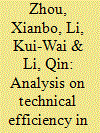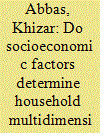|
|
|
Sort Order |
|
|
|
Items / Page
|
|
|
|
|
|
|
| Srl | Item |
| 1 |
ID:
106235


|
|
|
|
|
| Publication |
2011.
|
| Summary/Abstract |
This paper employs a fully nonparametric stochastic frontier model with time and individual effects to study technical efficiency in China's post-reform economy. The panel data cover China's thirty provinces for the period of 1985-2008. The empirical results show that the average output elasticity of labor is larger than the other two inputs of capital and human capital. Based on the specified inefficiency Tobit model, the factor analysis on technical efficiency shows that the time effects of technical efficiency in China's post-reform economy are significantly contingent on the factors. There exists significant regional differences in technical efficiency in China's economic development, and a number of policy implications can be drawn.
|
|
|
|
|
|
|
|
|
|
|
|
|
|
|
|
| 2 |
ID:
113945


|
|
|
|
|
| Publication |
2012.
|
| Summary/Abstract |
South Korea, the newest member to join the OECD's Development Assistance Committee, has signaled that it will become a major donor of official development assistance (ODA). Having had its own history of being a large recipient of ODA, South Korea claimed that it will provide aid from the recipient's perspective. Using panel data covering twenty-three years (1987-2009) and 154 recipient countries, we examine whether South Korea's ODA reflects the recipient nation's humanitarian needs more than the donor's interests. We ask three questions: (1) What are the major determinants of South Korea's ODA allocation? (2) Has South Korea's ODA policies changed over different time horizons-that is, years, political regimes? (3) Does South Korea exhibit different standards of allocating ODA for different groups of recipient countries? We find that South Korea provides more aid to higher-income developing countries with higher growth rates, which shows the tendency o t serve the donor's economic interests. When we examine the data by time periods, we do not find significant differences over decades or political regimes. However, when we reexamine the data based on recipients' income levels, we find that the relationship between per capita income of the recipient country and ODA allocation is negative only for the middle-income or lower-middle-income group recipients and positive for the rest. This finding suggests the possibility that South Korea's ODA policy may have a dual-track structure.
|
|
|
|
|
|
|
|
|
|
|
|
|
|
|
|
| 3 |
ID:
175246


|
|
|
|
|
| Summary/Abstract |
This paper examines the socioeconomic factors of energy poverty at the household level using a dataset of 674,834 households from six South Asian countries. An adjusted multidimensional energy poverty index (MEPI) is used to measure the extent and depth of energy poverty, and a Tobit model is employed to examine the significance of socioeconomic status for multidimensional energy poverty. An ordinary least squares (OLS) regression model is compared with the results of the Tobit model, using the combined dataset and the datasets for each country separately. House size, household wealth, education, occupation (clerical, sales, or agricultural), and gender of the head of the households are significant negative socioeconomic determinants of household multidimensional energy poverty. Place of residence, house ownership status, family size, and the age of the primary breadwinner play a significant positive role in multidimensional energy poverty. These results suggest that effective policy measures for improving the socioeconomic status of households will mitigate multidimensional energy poverty. With implications for the design and implementation of policy, the evidence-based results of this study will contribute to reducing the detrimental impacts of multidimensional energy poverty nationally, regionally, and globally.
|
|
|
|
|
|
|
|
|
|
|
|
|
|
|
|
| 4 |
ID:
184121


|
|
|
|
|
| Summary/Abstract |
Using three definitions of the middle class (MC) and the Pakistan Social and Living Standards Measurement surveys from 2004 to 2014, we estimated the size of the MC and examined the correlates and consumption patterns of the MC for Pakistan. According to the absolute income, relative income and asset–ownership definitions, the MC grew by 16%, 8%, and 10%, respectively, from 2004 to 2014. The results of the biprobit model showed that the probability of entering the MC was associated with higher education, urban residence and non-agricultural employment. Additionally, the MC was associated with greater consumption of ordinary and luxury goods.
|
|
|
|
|
|
|
|
|
|
|
|
|
|
|
|
| 5 |
ID:
103608


|
|
|
|
|
| Publication |
2011.
|
| Summary/Abstract |
This paper uses a total-factor framework to investigate energy efficiency in 23 developing countries during the period of 1980-2005. We explore the total-factor energy efficiency and change trends by applying data envelopment analysis (DEA) window, which is capable of measuring efficiency in cross-sectional and time-varying data. The empirical results indicate that Botswana, Mexico and Panama perform the best in terms of energy efficiency, whereas Kenya, Sri Lanka, Syria and the Philippines perform the worst during the entire research period. Seven countries show little change in energy efficiency over time. Eleven countries experienced continuous decreases in energy efficiency. Among five countries witnessing continuous increase in total-factor energy efficiency, China experienced the most rapid rise. Practice in China indicates that effective energy policies play a crucial role in improving energy efficiency. Tobit regression analysis indicates that a U-shaped relationship exists between total-factor energy efficiency and income per capita.
|
|
|
|
|
|
|
|
|
|
|
|
|
|
|
|
|
|
|
|
|